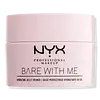What's inside
What's inside
 Key Ingredients
Key Ingredients

 Benefits
Benefits

 Concerns
Concerns

 Ingredients Side-by-side
Ingredients Side-by-side

Water
Skin ConditioningMethyl Trimethicone
Skin ConditioningPropanediol
SolventGlycerin
HumectantCetyl Ethylhexanoate
EmollientButylene Glycol
HumectantPentylene Glycol
Skin Conditioning1,2-Hexanediol
Skin ConditioningMica
Cosmetic ColorantGlycereth-26
HumectantCI 77891
Cosmetic ColorantLitchi Chinensis Fruit Extract
Skin ConditioningPsidium Guajava Fruit Extract
AstringentCarica Papaya Fruit Extract
Skin ConditioningChlorella Vulgaris Extract
Skin ConditioningTin Oxide
AbrasivePEG-100 Stearate
Hdi/Trimethylol Hexyllactone Crosspolymer
Potassium Cetyl Phosphate
EmulsifyingSorbitan Oleate
EmulsifyingSorbitan Olivate
EmulsifyingSorbitan Sesquioleate
EmulsifyingGlucose
HumectantFructooligosaccharides
HumectantFructose
HumectantGlyceryl Stearate
EmollientTrideceth-10
CleansingTriethoxycaprylylsilane
Cetearyl Olivate
Isohexadecane
EmollientSodium Acrylate/Sodium Acryloyldimethyl Taurate Copolymer
Emulsion StabilisingSodium Polyacrylate
AbsorbentSodium Polyacryloyldimethyl Taurate
Emulsion StabilisingSilica
AbrasiveCarica Papaya Fruit Water
Skin ConditioningAluminum Hydroxide
EmollientHydrogenated Polydecene
EmollientCitric Acid
BufferingTrisodium Ethylenediamine Disuccinate
Synthetic Fluorphlogopite
Ethylhexylglycerin
Skin ConditioningPolysorbate 80
EmulsifyingPotassium Sorbate
PreservativeSodium Benzoate
MaskingPhenoxyethanol
PreservativeCI 77491
Cosmetic ColorantCI 77492
Cosmetic ColorantParfum
MaskingWater, Methyl Trimethicone, Propanediol, Glycerin, Cetyl Ethylhexanoate, Butylene Glycol, Pentylene Glycol, 1,2-Hexanediol, Mica, Glycereth-26, CI 77891, Litchi Chinensis Fruit Extract, Psidium Guajava Fruit Extract, Carica Papaya Fruit Extract, Chlorella Vulgaris Extract, Tin Oxide, PEG-100 Stearate, Hdi/Trimethylol Hexyllactone Crosspolymer, Potassium Cetyl Phosphate, Sorbitan Oleate, Sorbitan Olivate, Sorbitan Sesquioleate, Glucose, Fructooligosaccharides, Fructose, Glyceryl Stearate, Trideceth-10, Triethoxycaprylylsilane, Cetearyl Olivate, Isohexadecane, Sodium Acrylate/Sodium Acryloyldimethyl Taurate Copolymer, Sodium Polyacrylate, Sodium Polyacryloyldimethyl Taurate, Silica, Carica Papaya Fruit Water, Aluminum Hydroxide, Hydrogenated Polydecene, Citric Acid, Trisodium Ethylenediamine Disuccinate, Synthetic Fluorphlogopite, Ethylhexylglycerin, Polysorbate 80, Potassium Sorbate, Sodium Benzoate, Phenoxyethanol, CI 77491, CI 77492, Parfum
 Reviews
Reviews

Ingredients Explained
These ingredients are found in both products.
Ingredients higher up in an ingredient list are typically present in a larger amount.
Butylene Glycol (or BG) is used within cosmetic products for a few different reasons:
Overall, Butylene Glycol is a safe and well-rounded ingredient that works well with other ingredients.
Though this ingredient works well with most skin types, some people with sensitive skin may experience a reaction such as allergic rashes, closed comedones, or itchiness.
Learn more about Butylene GlycolEthylhexylglycerin (we can't pronounce this either) is commonly used as a preservative and skin softener. It is derived from glyceryl.
You might see Ethylhexylglycerin often paired with other preservatives such as phenoxyethanol. Ethylhexylglycerin has been found to increase the effectiveness of these other preservatives.
Glycerin is already naturally found in your skin. It helps moisturize and protect your skin.
A study from 2016 found glycerin to be more effective as a humectant than AHAs and hyaluronic acid.
As a humectant, it helps the skin stay hydrated by pulling moisture to your skin. The low molecular weight of glycerin allows it to pull moisture into the deeper layers of your skin.
Hydrated skin improves your skin barrier; Your skin barrier helps protect against irritants and bacteria.
Glycerin has also been found to have antimicrobial and antiviral properties. Due to these properties, glycerin is often used in wound and burn treatments.
In cosmetics, glycerin is usually derived from plants such as soybean or palm. However, it can also be sourced from animals, such as tallow or animal fat.
This ingredient is organic, colorless, odorless, and non-toxic.
Glycerin is the name for this ingredient in American English. British English uses Glycerol/Glycerine.
Learn more about GlycerinPhenoxyethanol is a preservative that has germicide, antimicrobial, and aromatic properties. Studies show that phenoxyethanol can prevent microbial growth. By itself, it has a scent that is similar to that of a rose.
It's often used in formulations along with Caprylyl Glycol to preserve the shelf life of products.
Water. It's the most common cosmetic ingredient of all. You'll usually see it at the top of ingredient lists, meaning that it makes up the largest part of the product.
So why is it so popular? Water most often acts as a solvent - this means that it helps dissolve other ingredients into the formulation.
You'll also recognize water as that liquid we all need to stay alive. If you see this, drink a glass of water. Stay hydrated!
Learn more about Water